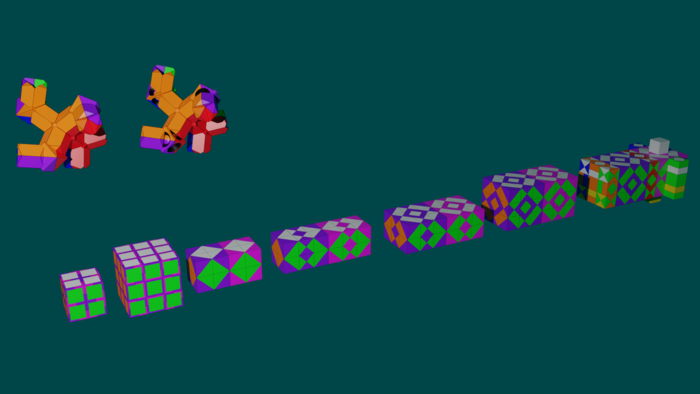Physical Puzzle
Contents
Definiton
In the context of hypercubing, a physical puzzle refers to an N+1 dimensional puzzle projected in N dimensions, such that the projection is operationally equivalent, i.e. the projection "emulates" the true puzzle. Usually, if not specified, it is used to refer to a 4D puzzle projected in 3D.
2D Physical Puzzles
When designing 3D physical puzzle it's a good idea to try and step down the problem by first looking at what the 2D physical analog would look like.For example,the 2^3,or by it's more recognizeable name,the 2x2x2,can be projected down into 2D by splitting it in 2 halves and putting them next to each other along the X or Y axis.By doing this,the Z axis will coincide with the X or the Y axis,which will make certain moves to be inaccessible without the use of a gyro algorithm to reorient the puzzle(the gyro algorithm does a cube rotation).
3D Physical Puzzles
The first physical puzzle was the 2^4 designed by Melinda Green in 2017. After this Grant,Luna,Hactar and Markk designed and built many other 3D physical puzzles based on Melinda's 2^4 design,like the 3^4,the simplex and hypercuboids like 2x2x3x3.There where attemps at designing shapeshifting physical puzzles with no success.
3D Physical designs list
2^4-Melinda Green | 2017
2x2x2x3-Luna | December 2021
2x2x3x3-Grant and Hactar | May 2022
2x3x3x3-Luna and Hactar
3^4-Grant
1x2x2x2,1x2x2x3,1x2x3x3,1x3x3x3-Grant
3x3 Simplex and Bandaged Void Simplex-Markk | August 2022
Physical Shapeshifting Puzzles
Physical shapeshifting puzzles are hard to design, if not impossible, because of their shapeshifting nature. All the current 2D and 3D designs don't fully work, in some solved states appearing as they're scrambled.




